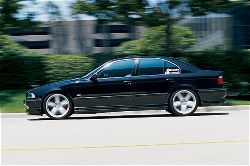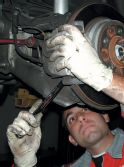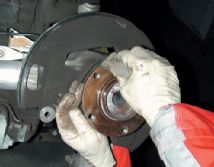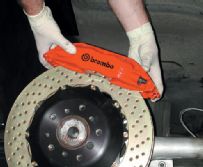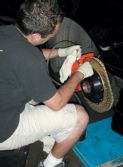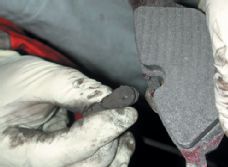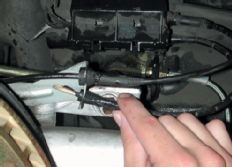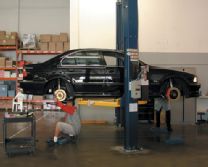It’s ironic when you think about it—you’re spending a grip of money on brake upgrades in the hopes that you’ll decrease the amount of time you spend using them.
Unfortunately, many people don’t even put that much thought into the braking system of their cars until it’s too late. How do you know it’s too late? When you finish with the slowest lap time at your local track, or when you slam on the brakes as someone runs a red light, and the next sound you hear is screeching tires and a loud bang.
Unless you’re racing professionally, the latter of these examples is the worst-case scenario. Many people have been involved in accidents where two or three feet have made the difference between an immaculate body and a tangled mess of sheetmetal, and it always sucks when you know a good brake upgrade would have made all the difference in the world.
And that’s exactly what we’re talking about: a couple of feet. A street- application brake upgrade, no matter how extreme, isn’t going to drop the braking distance on your ride by 50 feet. In most cases, you’ll be lucky to see a difference of 5 feet—and that’s what we were expecting from this brake upgrade. After all, the E-39 5-Series isn’t a light car, and BMWs are already extremely competent with their stock stoppers.
The stock BMW 5-Series front brakes use a non-directionally–vented, twin floating-piston setup with an extraordinarily large swept area. The brakes rarely fade, and stopping distances are usually shorter than most cars. We tested the stopping distance of the 5-Series with the stock brake setup and discovered the car averaged 135 feet braking from 60 mph. The first couple of runs yielded longer stopping distances than when the brakes had warmed up, telling us the factory pads were not designed for cold stops.
After the testing, we headed to Brembo’s U.S. headquarters in Costa Mesa, California, for a full brake upgrade. Brembo’s kit is for the front brakes only and includes a set of four-piston calipers, 355x32mm cross-drilled and directionally vented rotors, Ferodo street brake pads, Goodridge stainless steel braided brake lines, and all the bolts and relocation brackets you’ll need. In the rear, we installed Race Technologies nondirectionally–vented cross-drilled rotors and Pagid brake pads. The rear rotors are direct replacements for the OE ones, thus the rear, single-piston floating calipers were retained. When installing the rear Race Technologies rotors, there is no specific left or right rotor. The cross-drilled pattern on the rotors can face either direction, all depending on how you want the drill pattern to look. The front rotors, however, are directionally vented, and thus dictate the direction they must be installed. If you look at the vents on the rotors, you’ll see that they fan out from the center. Make sure that when the rotors are placed on the vehicle, the vents spin such that they throw the hot air out of the rotor. If the rotors are installed backward, where the vents scoop air into the rotors, hot air will be forced into the center of the rotors, heating up the brake components and causing premature brake fade. Since the Brembo setup is designed mostly for cold braking, positioning the rotors in the wrong direction would heat the brakes beyond their ideal operating temperature and adversely affect braking.
Next, you want to bleed the brakes. Brembo’s four-piston calipers have two bleeding plugs, one for the inside and one for the outside set of pistons. Because the Brembo calipers are so large and hold so much brake fluid, be sure not to run the brake reservoir dry. In case you’re looking for the brake reservoir on your E-39, you’ll find it under the driver-side air filter. Simply remove the entire intake housing and you’ll find the reservoir buried where no sane person would place a brake reservoir.
Once the brakes are installed and bled, the next step is to bed the pads and rotors. You want to do this by braking softly several times from 50 or 60 mph. The first couple of stops may be a little scary, but once you’ve done this enough times the pads and rotors will begin to work better together—and for the next 100 or 200 miles, try to keep your braking intensity fairly light. Once the brakes are properly bedded you can start braking harder and harder. If you mash the brakes before the brakes are bedded, you run the risk of glazing the pads. Glazing is where the resins in the pads crystallize on the rotors, resulting, in poor braking and excessive noise.
When we headed out to test the upgraded brakes, we were expecting a 3- or 4-foot decrease in stopping distance. We were also expecting the brakes to perform better from the start due to their street-use design, then fade marginally once several passes were made. The first pass dumfounded us. The BMW decelerated from 60 mph in 125 feet, 10 feet better than the stock average and 13 feet better than the first run with stock brakes. What amazed us more was the fact that the car stopped consistently in the mid-120-foot range. By the end of our testing, the BMW averaged 126 feet from 60 to 0 with no significant brake fade.
Brembo says its high performance brake kit is well suited for high-end street uses as well as limited track applications, and we’d have to agree with that. Although we didn’t get the chance to put the car on the track, our testing showed that the brakes weren’t prone to fade. Knowing the local Southern California tracks, it’s safe to say this BMW could handle a 20-minute session with little to no fuss.
The ultimate question is, of course, was the brake upgrade worth it? This upgrade was fairly expensive, but the end result was 9 feet knocked off the industry-standard 60-0 runs. Nine feet is a lot, and it is probably enough to save you from an accident or two on the streets. The large Brembo rotors and bright calipers also improve the appearance of the car more than just drop-in front rotors, nicely filling in the gap in the aftermarket wheels. Was it worth the money? Yes—but if you’re driving a 5-Series, money probably isn’t your first concern anyway.

